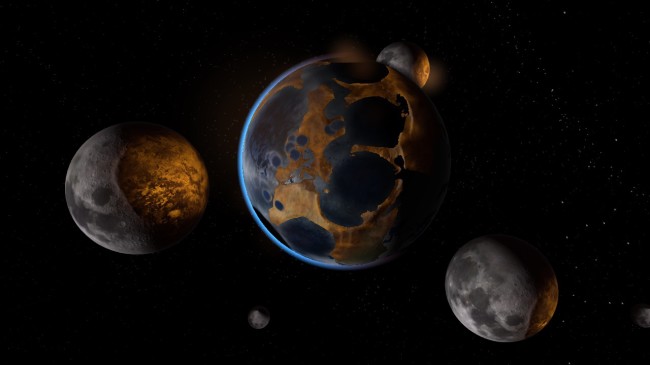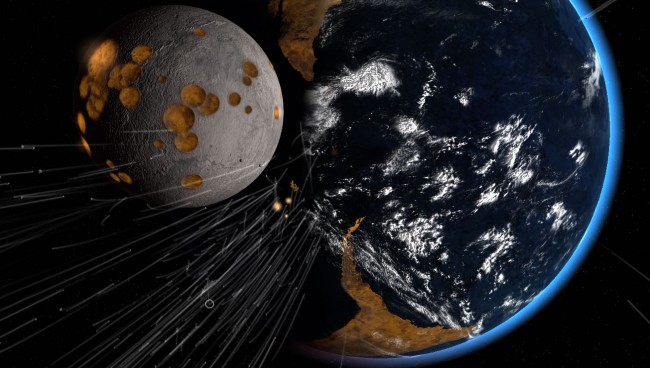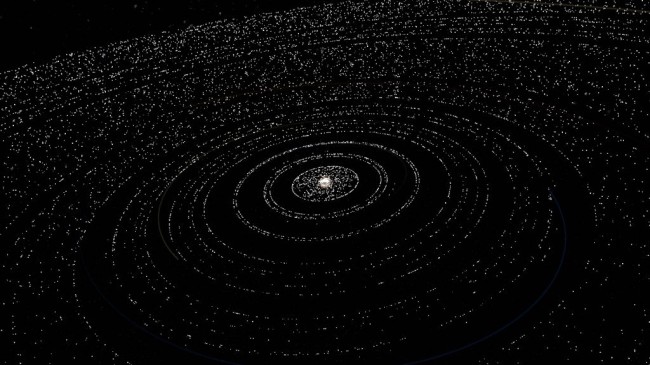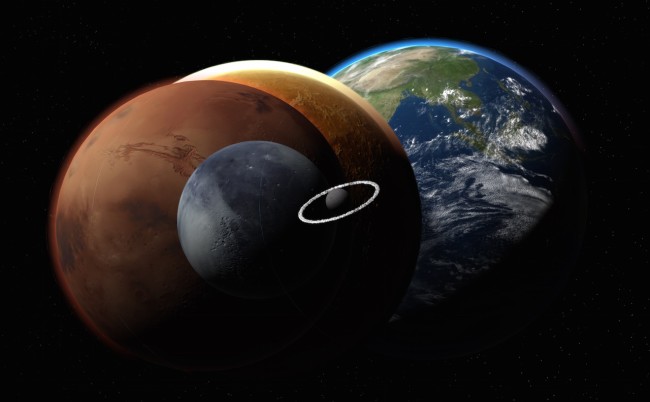Less Frequently Asked Questions about Universe Sandbox ²
Aug 1st
This is an LFAQ (less frequently asked questions). Here is an FAQ for Universe Sandbox ².
Will there be a mobile version?
Maybe. It is possible, but we wouldn’t begin development until after the initial release for PC, Mac, and Linux.
Will there be a free version?
We’re discussing the possibility of a feature-limited version, but not until after the initial release.
How much will it cost?
Pricing has not yet been decided. It will, however, cost more than the current price for the original Universe Sandbox ($9.95 USD). Educational discounts have not yet been determined either.
Will it support other languages beyond English?
After the initial release, we plan to incorporate support for additional languages.
Will there be sound effects and/or music?
Yes, we are working with a composer who will be creating an original score. There will also be sound effects. If you’d rather experience the silent desolation of space, though, there will be an option to turn these off.
Will you be able to simulate evolution/life on planets?
We plan to incorporate very basic support for “life.” Essentially, given the right conditions — temperature, atmosphere, water, etc. — vegetation will grow on planets. Greater complexity may be developed in the future, but it’s a long way off.
Will there be support for Steam Workshop?
We plan to add support for Steam Workshop that will, in the least, allow for sharing user-created simulations.
How about modding?
Making it easy for the community to create mods is a great idea. “Light” modding will hopefully be available by release, with more extensive modding possibilities made possible later on.
Humble Weekly Bundle: Simulators 2
Jul 17th
This week’s Humble Bundle features Universe Sandbox and 5 other great simulators.
And it also features an amazing trailer by Nerd³:
Name your price here: humblebundle.com/weekly
Universe Sandbox ² Alpha 8 Preview
Jul 15th
Universe Sandbox ² developers Chad and Georg recently hosted a live stream demo of Alpha 8.
They answered questions from the live stream chat and showed off various improvements and features in the upcoming alpha, including the latest iterations of collisions, climate simulation, and material composition.
https://www.youtube.com/watch?v=4pgHEO_Y9p4
Sign up here to be notified when the public alpha is available.
Universe Sandbox ² Physics Videos
Jun 24th
Take a peek behind the curtain with some videos made by one of our developers, Thomas. He’s recorded a whole bunch of demonstration videos that can be found on his channel: Thomas’s YouTube Channel.
https://www.youtube.com/watch?v=U7A2ry4CCJo
As the dedicated physics programmer, Thomas has lately been hard at work revamping and refining collisions in Universe Sandbox ².
https://www.youtube.com/watch?v=1ZQhxae0lMA
Our Alpha testers have just begun to dig into Alpha 7, which shows off a completely reworked collision system. But the work of a physics programmer is never complete, so subscribe to Thomas’s YouTube channel to stay updated on his progress in simulating the universe.
Universe Sandbox ² Alpha 7 Preview
Jun 11th
Watch Chad run through some of the new features and updates in the upcoming Alpha 7:
https://www.youtube.com/watch?v=2FrYlxJj8j4
Included: terraforming Mars and turning it into a star, tidally locking the Earth, and the ever-popular but now better looking Moon & Earth collision.
Universe Sandbox ² is currently in closed Alpha testing. You can read more about it as well as sign up to be notified when it’s available on our site: http://
Updates on the Road to Public Alpha
Jun 6th
If you haven’t yet, head over to our new page for Universe Sandbox ² and sign up to be notified when it’s available: universesandbox.com/2
What have we done recently and what are we doing now?
Good question. We’ve been very busy…
- Working with our newest team member, Chad Jenkins
- Building a brand new website and logo for Universe Sandbox ²
- Overhauling the new Collision system
- better physics+ better visuals = even more realistic and mesmerizing collisions
- Integrating the new Materials system
- view and change the material composition of any planet or star
- Developing an Interactions mode and toolset
- an even easier, more intuitive (and more fun) method for manipulating properties and values
- push/pull force power, material hose/stream cannon for adding material to planets
- Integrating climate support for a tidally-locked Earth
Rest assured, there will be much more to say, and much more to see, on each of these points soon enough. Until then, here’s another screenshot from our collision tests:
Collisions and Craters
May 9th
Orbital Resonance in Universe Sandbox ²
Apr 8th
Universe Sandbox ² is as much about breaking the rules as it is following them. This is why you’re given the ability to add Saturn-like rings to any body, whether it’s Earth, Mars, or even the Sun. And it’s also why we allow you to put in all kinds of interesting but unrealistic shapes for the ‘rings,’ like spirals and cubes. But, of course, we are also committed to incorporating and simulating as much science as we can. So we’ve included resonance gaps.
The basic idea here is that a larger body, like a moon (in the case of a ring around a planet), or a planet (in the case of rings around a star) creates gaps, or resonances, as seen in the picture above.
Here’s how it works (and for simplicity’s sake, just imagine circular orbits): According to Kepler’s third law, the distance an object is away from the planet determines how long it takes to orbit. That means that for an object at a given distance (and orbital period), there must be a distance where the orbit takes only half the time, and another distance that takes three times as long. Whenever the two orbits take integer ratios of each other, we say the orbits are in resonance. For example, if the moon takes 28 days to orbit, there is a distance that only takes 14 days to orbit. This would be the 2:1 resonance (two orbits for every one orbit of the moon). If there is a disk present, and there is material at that distance, then every other time the material in the disk orbits, the moon has gone the whole way around, and the disk material comes as close to the moon as it can get — basically they are in the same part of their respective orbits. Each time that happens, the moon’s gravity pulls on the material just a little bit. For certain ratios of orbit periods, this little extra pull will clear the material out of that particular orbit. It’s really an amazing process that takes a fair bit of time to occur. But we see it in Saturn’s rings and we see it in the asteroid belt, where resonances with Jupiter have cleared out gaps (the Kirkwood gaps). And here is a great little animation showing resonance in Jupiter’s moons.
We calculate a handful of unstable resonances (3:1, 5:2, 7:3, 2:1, 7:6, and 1:1). So when you’re playing around with Universe Sandbox 2, and you include resonance gaps, you’ll see these rifts in the rings. If you select the Sun and try to add rings, we find the planets that orbit the Sun, compute the resonances, and put gaps there, as pictured above. It’s pretty slick, if I do say so myself.
This feature includes the gaps when a ring is placed around an object. But Universe Sandbox is a gravity simulator, and this is a gravitational process. In principle, the gaps would develop on their own if you let the simulation run long enough. In practice, though, the simulation would need very, very high precision and to run for a very, very long time, and until we are running Universe Sandbox on a supercomputer, ring gaps won’t develop spontaneously.
You can also place your own rings by specifying the inner and outer boundaries of a single ring. So you could build up a single ring system with gaps anywhere you’d like them to be. We hope you have fun playing around with this feature when we make Universe Sandbox ² available for purchase. I sure had fun coding it up.
In other ring-related news, it was announced last week, to everyone’s surprise, that an asteroid in our Solar System called Chariklo has 2 rings. Here it is in Universe Sandbox ²:
Why do small stars not age past 12.6 billion years in Universe Sandbox ²?
Jan 10th
Universe Sandbox ², currently in development, is a powerful gravity simulator that invites you to learn about our amazing universe and fragile planet via an expanding realm of realistic, interconnected astronomy and climate physics systems. Read more about this upcoming version here: The New Universe Sandbox. Or find out how to purchase the currently available version at universesandbox.com/buy/.
Q: In Universe Sandbox 2, small stars, such as red dwarfs, stop aging when they reach 12.6 billion years old. Why is this?
A: Stellar evolution is incredibly complicated. We understand the basics of it quite well, and for a lot of stars, our models do a really good job of matching up to measurements of real stars. It is, however, very hard to do this right, for several reasons:
1. We don’t have perfect data.
We can’t directly measure the mass or radius of a real star. And even something like the temperature of a star isn’t always easy to measure. This means that a lot of the data are rough estimations.
One really big issue is what astronomers call ‘metallicity’. Basically, what is the relative fraction of elements in a star? How much iron is there, relative to hydrogen, etc?
2. We can’t actually observe the evolution of a single star.
We can watch it, but so far, we’ve only been watching for maybe a few decades or so, depending on when you consider our technology to have been good enough to do any of this. In star years, that’s not even a blink of the eye. So we have to make assumptions about the way a star will age by looking at other, older stars. It’s like looking at a whole bunch of people and guessing how you will age by seeing what older people look like right now. You can make an estimation, but it won’t be exact, because how you age depends a bit on what you eat, what happens to you, your genes, etc., and these factors are inevitably different than those of the older folks. Similarly, we can guess what the sun will do, but it has slightly different properties of the stars we think it will look like.
3. We can’t see inside a star.
And this is where most of the action happens. So this is all based on physics calculations. We’re good at that, but not perfect.
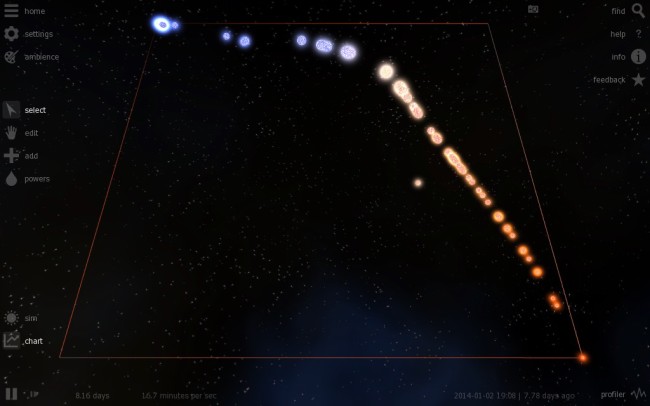
Hertzsprung–Russell diagram in Universe Sandbox. The HR Diagram (star’s temperature versus luminosity) was introduced in the early 20th century and helped pave the way for a better understanding of stellar evolution.
Okay, now on to how this directly relates to Universe Sandbox ²:
Since stellar evolution is so hard, we let the full-time, professional astronomers compute the models. We’ve adopted a whole suite of these stellar evolution models, or “isochrones.” These isochrones tell us the temperature, radius, and luminosity for a range of stellar masses and ages, and we turn that data into what you see in Universe Sandbox.
Unfortunately, although these isochrones are quite good and pretty accurate, they don’t give us predictions for very low-mass stars (less than 10% of the Sun’s mass) or very high-mass stars. And they don’t give us predictions for longer timeframes, such as 12.6 billion years (recall the age of the universe is a bit less than 14 billion years).
So this is what we’re stuck with for the time being. In the future, we’re planning on incorporating some other isochrones that are focused on lower-mass stars (which call for different physics, since the stellar atmospheres are very different; at low temperatures, molecules and even clouds can form in the stellar atmosphere, requiring different models), higher mass stars, different metallicities, and longer timeframes.
This is a work in progress, but we’ll be making it better and better as we go.
Follow the links below to read more about stellar evolution and some of the terms used in this post.
http://en.wikipedia.org/wiki/Stellar_evolution
http://en.wikipedia.org/wiki/Stellar_isochrone
http://en.wikipedia.org/wiki/Metallicity
http://stev.oapd.inaf.it/cgi-bin/cmd
Universe Sandbox 75% off at Huge Seal
Nov 20th
The Huge Seal Steam coupon giveaway continues for 5 more days!
Head on over to hugeseal.com to get Universe Sandbox for 75% off.
Use two more coupons and you’ll get another game completely free.
From their site: Huge Seal is a Steam Discount Coupon giveaway where you get to choose 5 Steam Discount Coupons from a list of over 30 indie games by logging on to hugeseal.com with your Steam account. And when you purchase 3 games with the coupons, you get one random Steam key for free!
The campaign ends on November 24th, so be sure to get going while the going is good!
And while you’re busy clicking links, be sure to Like us on Facebook and follow us on Twitter @UniverseSandbox.



